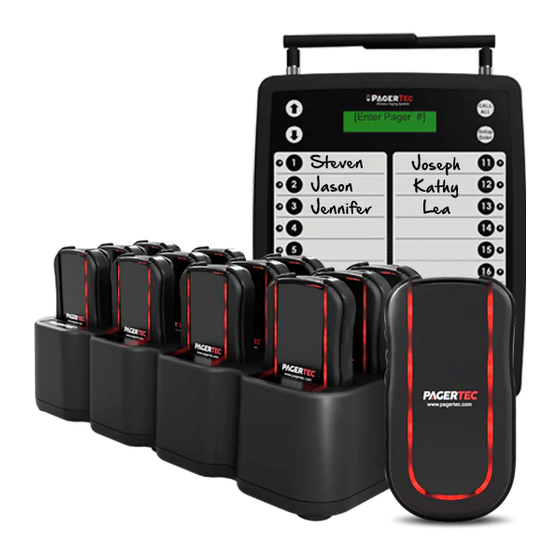Summary of Contents for pagertec TRACKSTAFF V3
- Page 1 TRACKSTAFF V3 PAGING SYSTEM (HOSTESS TRANSMITTER- INCLUDES 4-MESSAGE MODE) USER GUIDE...
- Page 2 Thank you for choosing Pagertec Thank you for choosing Pagertec as your provider for your wireless paging requirements. We greatly appreciate your confidence in our products. At Pagertec our greatest commitment is providing you with total customer satisfaction. Please take a few minutes to review this manual prior to installing and operating your system.
- Page 3 Installing the Transmitter The first consideration in the placement of the transmitter is convenience. It should be readily accessible in a central location within the paging area. Pay close attention to nearby obstructions such as walls, pipes, ducts, mirrored glass, or other similar barriers that may weaken or misdirect transmitted signals.
-
Page 4: General Information
Installing the Trackstaff V3 Pagers GENERAL INFORMATION The Trackstaff V3 Pagers are used in conjunction with the Pagertec transmitters. The message pagers are used as an on-premise paging system to increase efficiency by alerting customers or staff. CHARGING BASE INSTALLATION 1. - Page 5 3. To call the pager: a) Key in the Pager Number that you wish to active b) Press “SEND” 5. Pagertec’s Trackstaff V3 4 message Pagers will flash, vibrate and/or beep depending on the alert mode. OPERATION (for 4-Message Mode) 1.
-
Page 6: Battery Installation
BATTERY INSTALLATION The rechargeable nickel metal hydride (NiMH) batteries will typically last from one to three years depending on usage. To replace the batteries , first remove the back lid screw using a small Phillips head screwdriver. Lift the back lid from the front of the pager. Place the front housing of the pager in a safe place for closure after changing the rechargeable batteries. - Page 7 After everything is attached, put the pin back in place and slide in until it locks. Replace clip with an appropriate replacement part available for purchase as an accessory from Pagertec. Metal Clip: To do this first remove the screw holding the clip on to the pager with a small screwdriver.
-
Page 8: System Programming
Pagertec pagers are made from industrial-strength, polycarbonate material. However, this material is susceptible to hairline cracking if non-approved cleaners are used. When cleaning Pagertec pagers, you should only use ETHYL ALCOHOL (ethanol) or ISOPROPYL ALCOHOL-BASED CLEANERS. We have done extensive testing with available cleaning materials and have not found any issues with either ethyl alcohol (ethanol) or isopropyl alcohol (IPA). - Page 9 SET ALERT MODE With this feature you can have the option of changing your pagers alert type. To change the alert type of your pagers follow the below instructions: At the “Set Alert mode” menu press the “ENTER” key Select one of 1~6 Alert modes then press “SEND” key. 1.
- Page 10 1. 2 SEC 2. 5 SEC 3. 10 SEC 4. 15 SEC 5. 30 SEC 6. 60 SEC 7. 90 SEC 8. 120 SEC 9. Continuance • The pagers will now respond with your new selected alert time mode. • Return all the pagers to the charger base or plug the power supply. The pagers are ready to receive the page with its new alert mode.
- Page 11 5 seconds. Walk around your property. When you reach the point where the pagers do not beep consistently, this is your maximum range. If you would like to increase your power level, exit range test and call Pagertec. •...
-
Page 12: Fcc Compliance And Advisory Statement
FCC COMPLIANCE AND ADVISORY STATEMENT This device complies with Part 15 of the FCC rules. Operation is subject to the following two conditions: (1) this device may not cause harmful interference, and (2) this device must accept any interference received, including interference that may cause undesired operation.







Need help?
Do you have a question about the TRACKSTAFF V3 and is the answer not in the manual?
Questions and answers